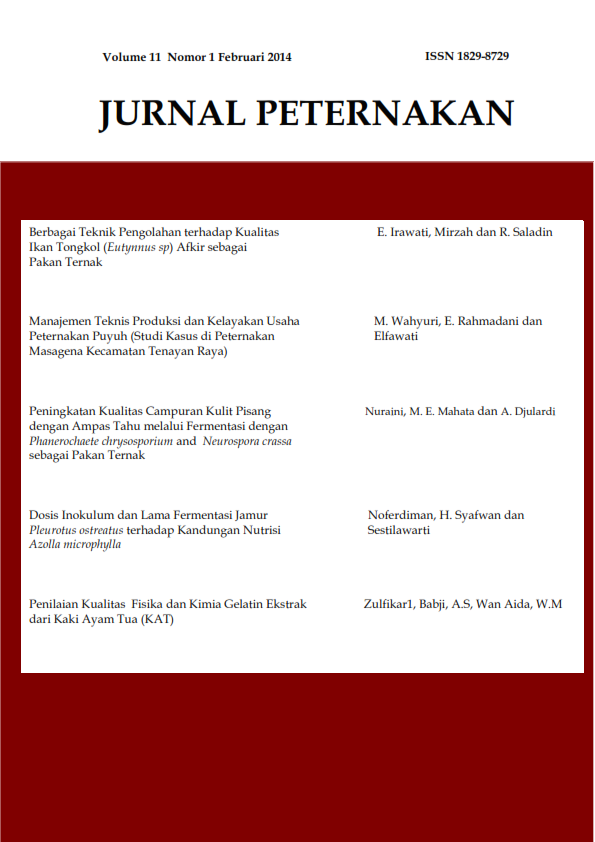BERBAGAI TEKNIK PENGOLAHAN TERHADAP KUALITAS IKAN TONGKOL (Eutynnus sp) AFKIR SEBAGAI PAKAN TERNAK
DOI:
https://doi.org/10.24014/jupet.v11i1.2322Keywords:
rejected little tuna, steaming, salting, nutritionAbstract
Rejected little tuna (Eutynnus sp) is alternative feed ingredient which same quality to commercial fish meal and the price is relatively cheaper. The aim of this research were to study the interaction between the salt level with time of steaming on the nutritional content (dry matter, crude protein, extract ether, crude fiber, calcium and phosphorus) of rejected little tuna meal. The experimental design was completely randomized design (CRD) 3 x 3 factorial pattern with 3 replications. The first factor was level of salting (A) (A1 = 2.5 %, A2 = 5.0%, A3 = 7.5%) the second factor was times of steaming (B) (B1 = 15 min, B2 = 30 min, B3 = 45 minutes). The results showed that the interaction between the level of salt to the time of steaming can maintain quality of rejected little tuna fish processed, it was seen with increasing of nutrient content of crude protein of rejected little tuna (50.16-64.42%), and the processing of rejected little tuna by salting and steaming highly significant effect (P <0.01) and there is a higly significant interaction (P <0.01) through the on dry matter and extract ether rejected little tuna processed. In conclusion, the processing of rejected little tuna by salting and steaming can maintain quality of rejected little tuna, it was seen with increasing of nutrient especially on crude protein (50.16-64.42), so that it can be used as animal feed.Downloads
Published
Issue
Section
License
The Authors submitting a manuscript do so on the understanding that if accepted for publication, copyright of the article shall be assigned to Jurnal Peternakan and published by Fakultas Pertanian dan Peternakan Universitas Islam Negeri Sultan Syarif Kasim Riau as publisher of the journal.
Authors who publish with this journal agree to the following terms:
Authors automatically transfer the copyright to the journal and grant the journal right of first publication with the work simultaneously licensed under a Creative Commons (CC BY) that allows others to share the work with an acknowledgement of the work's authorship and initial publication in this journal.
Authors are able to enter into separate permission for non-exclusive distribution of the journal's published version of the work (e.g., post it to an institutional repository or publish it in a book), with an acknowledgement of its initial publication in this journal.
Authors are permitted and encouraged to post their work online (e.g., in institutional repositories or on their website) prior to and during the submission process, as it can lead to productive exchanges, as well as earlier and greater citation of published work (See The Effect of Open Access).

